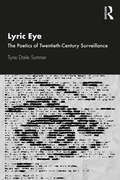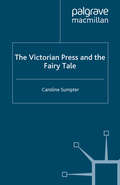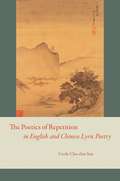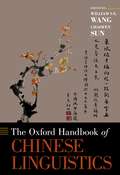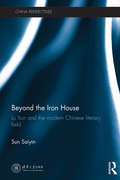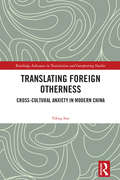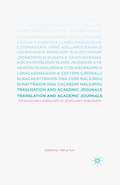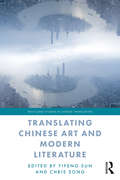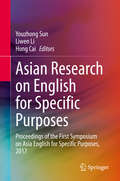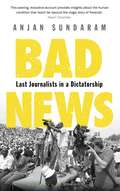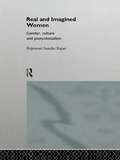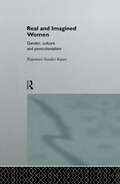- Table View
- List View
Lyric Eye: The Poetics of Twentieth-Century Surveillance
by Tyne Daile SumnerLyric Eye: The Poetics of Twentieth-Century Surveillance presents the first detailed study of the relationship between poetry and surveillance. It critically examines the close connection between American lyric poetry and a burgeoning U.S. state surveillance apparatus from 1920 to the 1960s. The book explores the myriad ways that poets—Ezra Pound, William Carlos Williams, W.H. Auden, Langston Hughes, James Baldwin, Sylvia Plath, Gertrude Stein, Robert Lowell, Allen Ginsberg and others—explored a developing and fraught environment in which the growing power of American investigative agencies, such as the FBI under J. Edgar Hoover, imposed new pressures on cultural discourse and personal identity. In analysing twentieth-century American poetry and its various ideas about "the self," Lyric Eye demonstrates the extent to which poetry and surveillance employ similar styles of information gathering such as observation, overhearing, imitation, abstraction, repurposing of language, subversion, fragmentation and symbolism. Ground-breaking and prescient, this book will be of great interest to scholars and researchers of literature, politics, surveillance and intelligence studies, and digital humanities.
Lyric Eye: The Poetics of Twentieth-Century Surveillance
by Tyne Daile SumnerLyric Eye: The Poetics of Twentieth-Century Surveillance presents the first detailed study of the relationship between poetry and surveillance. It critically examines the close connection between American lyric poetry and a burgeoning U.S. state surveillance apparatus from 1920 to the 1960s. The book explores the myriad ways that poets—Ezra Pound, William Carlos Williams, W.H. Auden, Langston Hughes, James Baldwin, Sylvia Plath, Gertrude Stein, Robert Lowell, Allen Ginsberg and others—explored a developing and fraught environment in which the growing power of American investigative agencies, such as the FBI under J. Edgar Hoover, imposed new pressures on cultural discourse and personal identity. In analysing twentieth-century American poetry and its various ideas about "the self," Lyric Eye demonstrates the extent to which poetry and surveillance employ similar styles of information gathering such as observation, overhearing, imitation, abstraction, repurposing of language, subversion, fragmentation and symbolism. Ground-breaking and prescient, this book will be of great interest to scholars and researchers of literature, politics, surveillance and intelligence studies, and digital humanities.
The Victorian Press and the Fairy Tale (Palgrave Studies in Nineteenth-Century Writing and Culture)
by C. SumpterThis book offers a new history of the fairy tale, revealing the creative role of periodical publication in shaping this popular genre. Sumpter explores the fairy tale's reinvention for (and by) diverse readerships in unexpected contexts, including debates over evolution, colonialism, socialism, gender and sexuality and decadence.
The Poetics of Repetition in English and Chinese Lyric Poetry
by Cecile Chu-chin SunFor more than half a century, Chinese-Western comparative literature has been recognized as a formal academic discipline, but critics and scholars in the field have done little to develop a viable, common basis for comparison between these disparate literatures. In this pioneering book, Cecile Chu-chin Sun establishes repetition as the ideal perspective from which to compare the poetry and poetics from these two traditions. Sun contends that repetition is at the heart of all that defines the lyric as a unique art form and, by closely examining its use in Chinese and Western poetry, she demonstrates howone can identify important points of convergence and divergence. Through a representative sampling of poems from both traditions, she illustrates how the irreducible generic nature of the lyric transcends linguistic and cultural barriers but also reveals the fundamental distinctions between the traditions. Most crucially, she dissects the two radically different conceptualizations of reality—mimesis and xing—that serve as underlying principles for the poetic practices of each tradition. Skillfully integrating theory and practice, The Poetics of Repetition in English and Chinese Lyric Poetryprovides a much-needed model for future study of Chinese and English poetry as well as lucid, succinct interpretations of individual poems.
The Poetics of Repetition in English and Chinese Lyric Poetry
by Cecile Chu-chin SunFor more than half a century, Chinese-Western comparative literature has been recognized as a formal academic discipline, but critics and scholars in the field have done little to develop a viable, common basis for comparison between these disparate literatures. In this pioneering book, Cecile Chu-chin Sun establishes repetition as the ideal perspective from which to compare the poetry and poetics from these two traditions. Sun contends that repetition is at the heart of all that defines the lyric as a unique art form and, by closely examining its use in Chinese and Western poetry, she demonstrates howone can identify important points of convergence and divergence. Through a representative sampling of poems from both traditions, she illustrates how the irreducible generic nature of the lyric transcends linguistic and cultural barriers but also reveals the fundamental distinctions between the traditions. Most crucially, she dissects the two radically different conceptualizations of reality—mimesis and xing—that serve as underlying principles for the poetic practices of each tradition. Skillfully integrating theory and practice, The Poetics of Repetition in English and Chinese Lyric Poetryprovides a much-needed model for future study of Chinese and English poetry as well as lucid, succinct interpretations of individual poems.
OHB CHINESE LINGUISTICS OHBK C (Oxford Handbooks)
by Chaofen Sun William S-Y WangThe Oxford Handbook of Chinese Linguistics offers a broad and comprehensive coverage of the entire field from a multi-disciplinary perspective. All chapters are contributed by leading scholars in their respective areas. This Handbook contains eight sections: history, languages and dialects, language contact, morphology, syntax, phonetics and phonology, socio-cultural aspects and neuro-psychological aspects. It provides not only a diachronic view of how languages evolve, but also a synchronic view of how languages in contact enrich each other by borrowing new words, calquing loan translation and even developing new syntactic structures. It also accompanies traditional linguistic studies of grammar and phonology with empirical evidence from psychology and neurocognitive sciences. In addition to research on the Chinese language and its major dialect groups, this handbook covers studies on sign languages and non-Chinese languages, such as the Austronesian languages spoken in Taiwan.
Global Social Media Design: Bridging Differences Across Cultures (Human Technology Interaction Series)
by Huatong SunSocial media users fracture into tribes, but social media ecosystems are globally interconnected technically, socially, culturally, and economically. At the crossroads, Huatong Sun, author of Cross-Cultural Technology Design, presents theory, method, and case studies to uncover the global interconnectedness of social media design and reorient universal design standards. Centering on the dynamics between structure and agency, Sun draws on practice theories and transnational fieldwork and articulates a critical design approach. The "CLUE2 (CLUE squared)" framework extends from situated activity to social practice, and connects macro institutions with micro interactions to redress asymmetrical relations in everyday life. Why were Japanese users not crazed about Facebook? Would Twitter have had been more successful than its copycat Weibo in China if not banned? How did mobilities and value propositions play out in the competition of WhatsApp, WeChat, LINE, and KakaoTalk for global growth? Illustrating the cultural entanglement with a relational view of design, Sun provides three provocative accounts of cross-cultural social media design and use. Concepts such as affordance, genre, and uptake are demonstrated as design tools to bind the material with the discursive and leap from the critical to the generative for culturally sustaining design. Sun calls to reshape the crossroads into a design square where differences are nourished as design resources, where diverse discourses interact for innovation, and where alternative design epistemes thrive from the local. This timely book will appeal to researchers, students, and practitioners who design across disciplines, paradigms, and boundaries to bridge differences in this increasingly globalized world.
Global Social Media Design: Bridging Differences Across Cultures (Human Technology Interaction Series)
by Huatong SunSocial media users fracture into tribes, but social media ecosystems are globally interconnected technically, socially, culturally, and economically. At the crossroads, Huatong Sun, author of Cross-Cultural Technology Design, presents theory, method, and case studies to uncover the global interconnectedness of social media design and reorient universal design standards. Centering on the dynamics between structure and agency, Sun draws on practice theories and transnational fieldwork and articulates a critical design approach. The "CLUE2 (CLUE squared)" framework extends from situated activity to social practice, and connects macro institutions with micro interactions to redress asymmetrical relations in everyday life. Why were Japanese users not crazed about Facebook? Would Twitter have had been more successful than its copycat Weibo in China if not banned? How did mobilities and value propositions play out in the competition of WhatsApp, WeChat, LINE, and KakaoTalk for global growth? Illustrating the cultural entanglement with a relational view of design, Sun provides three provocative accounts of cross-cultural social media design and use. Concepts such as affordance, genre, and uptake are demonstrated as design tools to bind the material with the discursive and leap from the critical to the generative for culturally sustaining design. Sun calls to reshape the crossroads into a design square where differences are nourished as design resources, where diverse discourses interact for innovation, and where alternative design epistemes thrive from the local. This timely book will appeal to researchers, students, and practitioners who design across disciplines, paradigms, and boundaries to bridge differences in this increasingly globalized world.
Representation Learning for Natural Language Processing
by Maosong Sun Zhiyuan Liu Yankai LinThis open access book provides an overview of the recent advances in representation learning theory, algorithms and applications for natural language processing (NLP). It is divided into three parts. Part I presents the representation learning techniques for multiple language entries, including words, phrases, sentences and documents. Part II then introduces the representation techniques for those objects that are closely related to NLP, including entity-based world knowledge, sememe-based linguistic knowledge, networks, and cross-modal entries. Lastly, Part III provides open resource tools for representation learning techniques, and discusses the remaining challenges and future research directions. The theories and algorithms of representation learning presented can also benefit other related domains such as machine learning, social network analysis, semantic Web, information retrieval, data mining and computational biology. This book is intended for advanced undergraduate and graduate students, post-doctoral fellows, researchers, lecturers, and industrial engineers, as well as anyone interested in representation learning and natural language processing.
Chinese as a Second Language Multilinguals’ Speech Competence and Speech Performance: Cognitive, Affective, and Sociocultural Perspectives
by Peijian Paul SunThis book offers a comprehensive and systematic review of multilingual L2 learners’ spoken Chinese, focusing on the dual dimensions of speech competence and speech performance. Specifically, by adopting a mixed-methods approach, it explores the cognitive, affective, and socio-cultural differences between intermediate and advanced multilingual learners’ L2 Chinese speech competence and speech performance. Drawing on a theoretical framework underpinned by the affective filter hypothesis, L2 willingness to communicate model, L2 motivational self-system, and L2 speech production models, this book not only contributes to our theoretical understanding of the roles of various factors in L2 Chinese speech competence and speech performance, but also offers practical insights into the implications for both teachers and learners in terms of how to minimize the gap between these two dimensions among L2 Chinese learners. It concludes with a discussion on the limitations of L2 Chinese speech and on future directions for the field.
Beyond the Iron House: Lu Xun and the Modern Chinese Literary Field (China Perspectives)
by Saiyin SunBeyond the Iron House is a critical study of a crucial period of life and work of the modern Chinese writer Lu Xun. Through thorough research into historical materials and archives, the author demonstrates that Lu Xun was recognized in the literary field much later than has hitherto been argued. Neither the appearance of "Kuangren riji" (Diary of a madman) in 1918 nor the publication of Nahan (Outcry) in 1923 had catapulted the author into nationwide prominence; in comparison with his contemporaries, neither was his literary work as original and unique as many have claimed, nor were his thoughts and ideas as popular and influential as many have believed; like many other agents in the literary field, Lu Xun was actively involved in power struggles over what was at stake in the field; Lu Xun was later built into an iconic figure and the blind worship of him hindered a better and more authentic understanding of many other modern writers and intellectuals such as Gao Changhong and Zhou Zuoren, whose complex relationships with Lu Xun are fully explored and analysed in the book.
Beyond the Iron House: Lu Xun and the Modern Chinese Literary Field (China Perspectives)
by Saiyin SunBeyond the Iron House is a critical study of a crucial period of life and work of the modern Chinese writer Lu Xun. Through thorough research into historical materials and archives, the author demonstrates that Lu Xun was recognized in the literary field much later than has hitherto been argued. Neither the appearance of "Kuangren riji" (Diary of a madman) in 1918 nor the publication of Nahan (Outcry) in 1923 had catapulted the author into nationwide prominence; in comparison with his contemporaries, neither was his literary work as original and unique as many have claimed, nor were his thoughts and ideas as popular and influential as many have believed; like many other agents in the literary field, Lu Xun was actively involved in power struggles over what was at stake in the field; Lu Xun was later built into an iconic figure and the blind worship of him hindered a better and more authentic understanding of many other modern writers and intellectuals such as Gao Changhong and Zhou Zuoren, whose complex relationships with Lu Xun are fully explored and analysed in the book.
Translating Foreign Otherness: Cross-Cultural Anxiety in Modern China (Routledge Advances in Translation and Interpreting Studies)
by Yifeng SunThis book explores the deep-rooted anxiety about foreign otherness manifest through translation in modern China in its endeavours to engage in cross-cultural exchanges. It offers to theorize and contextualize a related range of issues concerning translation practice in response to foreign otherness. The book also introduces new vistas to some of the under-explored aspects of translation practice concerning ideology and cultural politics from the late Qing dynasty to the present day. Largely as a result of translation, ethnocentric beliefs and feelings have given way to a more open and liberal way to approach and appropriate foreign otherness. However, the fear of Westernization, seen as a threat to Chinese cultural integrity and social stability, is still shown sporadically through the state’s ideological control over translation. The book interprets, questions and reformulates a number of the key theoretical issues in Translation Studies and also demonstrates their ramifications in a bid to shed light on Chinese translation practice.
Translating Foreign Otherness: Cross-Cultural Anxiety in Modern China (Routledge Advances in Translation and Interpreting Studies)
by Yifeng SunThis book explores the deep-rooted anxiety about foreign otherness manifest through translation in modern China in its endeavours to engage in cross-cultural exchanges. It offers to theorize and contextualize a related range of issues concerning translation practice in response to foreign otherness. The book also introduces new vistas to some of the under-explored aspects of translation practice concerning ideology and cultural politics from the late Qing dynasty to the present day. Largely as a result of translation, ethnocentric beliefs and feelings have given way to a more open and liberal way to approach and appropriate foreign otherness. However, the fear of Westernization, seen as a threat to Chinese cultural integrity and social stability, is still shown sporadically through the state’s ideological control over translation. The book interprets, questions and reformulates a number of the key theoretical issues in Translation Studies and also demonstrates their ramifications in a bid to shed light on Chinese translation practice.
Translation and Academic Journals: The Evolving Landscape of Scholarly Publishing
by Yifeng SunThis volume comes at a time of rapid expansion in the discipline of Translation Studies and the growth of related journals. Experts and editors of leading journals in the field probe the interactive relationship between the production of journals and the development of Translation Studies and provide a contextual framework for evaluating the field.
Transcultural Poetics: Chinese Literature in English Translation
by Yifeng Sun Dechao LiThis book examines many facets of transcultural poetics in the English translation of Chinese literature from 12 different expert contributors.Translating Chinese literature into English is a special challenge. There is a pressing need to overcome a slew of obstacles to the understanding and appreciation of Chinese literary works by readers in the English-speaking world. Hitherto only intermittent attempts have been made to theorize and explore the exact role of the translator as a cultural and aesthetic mediator informed by cross-cultural knowledge, awareness, and sensitivity. Given the complexity of literary translation, sophisticated poetics of translation in terms of literary value and aesthetic taste needs to be developed and elaborated more fully from a cross-cultural perspective. It is, therefore, necessary to examine attempts to reconcile the desire for authentic transmission of Chinese culture with the need for cultural mediation and appropriation in terms of the production and reception of texts, subject to the multiplicity of constraints, in order to shed new light on the longstanding conundrum of Chinese-English literary translation by addressing Chinese literature in the multiple contexts of nationalism, cross-cultural hybridity, literary untranslatability, the reception of translation, and also world literature. The book will be of great interest to students and scholars of translation studies, Chinese literature, and East Asian studies.
Transcultural Poetics: Chinese Literature in English Translation
by Yifeng Sun Dechao LiThis book examines many facets of transcultural poetics in the English translation of Chinese literature from 12 different expert contributors.Translating Chinese literature into English is a special challenge. There is a pressing need to overcome a slew of obstacles to the understanding and appreciation of Chinese literary works by readers in the English-speaking world. Hitherto only intermittent attempts have been made to theorize and explore the exact role of the translator as a cultural and aesthetic mediator informed by cross-cultural knowledge, awareness, and sensitivity. Given the complexity of literary translation, sophisticated poetics of translation in terms of literary value and aesthetic taste needs to be developed and elaborated more fully from a cross-cultural perspective. It is, therefore, necessary to examine attempts to reconcile the desire for authentic transmission of Chinese culture with the need for cultural mediation and appropriation in terms of the production and reception of texts, subject to the multiplicity of constraints, in order to shed new light on the longstanding conundrum of Chinese-English literary translation by addressing Chinese literature in the multiple contexts of nationalism, cross-cultural hybridity, literary untranslatability, the reception of translation, and also world literature. The book will be of great interest to students and scholars of translation studies, Chinese literature, and East Asian studies.
Translating Chinese Art and Modern Literature (Routledge Studies in Chinese Translation)
by Yifeng Sun Chris SongTranslating Chinese Art and Modern Literature examines issues in cross-cultural dialogue in connection with translation and modern Chinese art and literature from interdisciplinary perspectives. This comprises the text-image dialogue in the context of Chinese modernity, and cross-cultural interaction between modern literature in Chinese and other literatures. This edited collection approaches these issues with discrete foci and approaches, and the ten chapters in this volume are to be divided into two distinct parts. The first part highlights the mutual effects between literary texts and visual images in the media of book, painting, and film, and the second part includes contributions by scholars of literary translation.
Translating Chinese Art and Modern Literature (Routledge Studies in Chinese Translation)
by Yifeng Sun Chris SongTranslating Chinese Art and Modern Literature examines issues in cross-cultural dialogue in connection with translation and modern Chinese art and literature from interdisciplinary perspectives. This comprises the text-image dialogue in the context of Chinese modernity, and cross-cultural interaction between modern literature in Chinese and other literatures. This edited collection approaches these issues with discrete foci and approaches, and the ten chapters in this volume are to be divided into two distinct parts. The first part highlights the mutual effects between literary texts and visual images in the media of book, painting, and film, and the second part includes contributions by scholars of literary translation.
Asian Research on English for Specific Purposes: Proceedings of the First Symposium on Asia English for Specific Purposes, 2017
by Youzhong Sun Liwen Li Hong CaiEnglish for Specific Purposes (ESP), addressing the communicative needs and practices of particular professional or occupational groups, has developed rapidly in the past fifty years and is now a major force in English language teaching and research. This critical volume helps innovate the theory, practice, and methodology for ESP teaching and research in Asian countries and areas. Promoting communication and enhancing cooperation on ESP research and pedagogy across cultures, it provides ESP scholars, educators and practitioners with an opportunity to benefit from each other’s research and expertise in an age of globalization and digitalization. The volume provides an in-depth analysis of the latest scholarship on English teaching and research for general and specific academic and occupational purposes; the intercultural communication in ESP contexts; corpus linguistics and data-driven instruction for ESP; computer-assisted language learning and mobile-assisted language learning; evaluation of English writing courses; and ESP translation strategies.
Language, Discourse, and Praxis in Ancient China
by Zhenbin SunThis book investigates Chinese comprehension and treatment of the relationship between language and reality. The work examines ancient Chinese philosophy through the pair of concepts known as ming-shi. By analyzing the pre-Qin thinkers’ discourse on ming and shi, the work explores how Chinese philosophers dealt with issues not only in language but also in ontology, epistemology, ethics, axiology, and logic. Through this discourse analysis, readers are invited to rethink the relationship of language to thought and behavior. The author criticizes and corrects vital misunderstandings of Chinese culture and highlights the anti-dualism and pragmatic character of Chinese thoughts. The rich meaning of the ming-shi pair is displayed by revealing its connection to other philosophical issues. The chapters show how discourse on language and reality shapes a central characteristic of Chinese culture, the practical zhi. They illuminate the interplay of Chinese theories of language and Dao as Chinese wisdom and worldview. Readers who are familiar with pragmatics and postmodernism will recognize the common points in ancient Chinese philosophy and contemporary Western philosophy, as they emerge through these chapters. The work will particularly appeal to scholars of philosophy, philosophy of language, communication studies and linguistics.
Bad News: Last Journalists in a Dictatorship
by Anjan SundaramHearing a blast, journalist Anjan Sundaram headed uphill towards the sound. Grenade explosions are not entirely unusual in the city of Kigali; dissidents throw them in public areas to try and destabilise the government and, since moving to Rwanda, he had observed an increasing number of them. What was unusual about this one, however, was that when Sundaram arrived, it was as though nothing had happened. Traffic circulated as normal, there was no debris on the streets and the policeman on duty denied any event whatsoever. This was evidence of a clean-up, a cloaking of the discontent in Rwanda and a desire to silence the media in a country most of whose citizens were without internet. This was the first of many ominous events. Bad News is the extraordinary account of the battle for free speech in modern-day Rwanda. Following not only those journalists who stayed, despite fearing torture or even death from a ruthless government, but also those reporting from exile, it is the story of papers being shut down, of lies told to please foreign delegates, of the unshakeable loyalty that can be bred by terror, of history being retold, of constant surveillance, of corrupted elections and of great courage. It tells the true narrative of Rwandan society today and, in the face of powerful forces, of the fight to make explosions heard.
Real and Imagined Women: Gender, Culture and Postcolonialism
by Rajeswari Sunder RajanFirst published in 1993. Routledge is an imprint of Taylor & Francis, an informa company.
Real and Imagined Women: Gender, Culture and Postcolonialism
by Rajeswari Sunder RajanFirst published in 1993. Routledge is an imprint of Taylor & Francis, an informa company.

